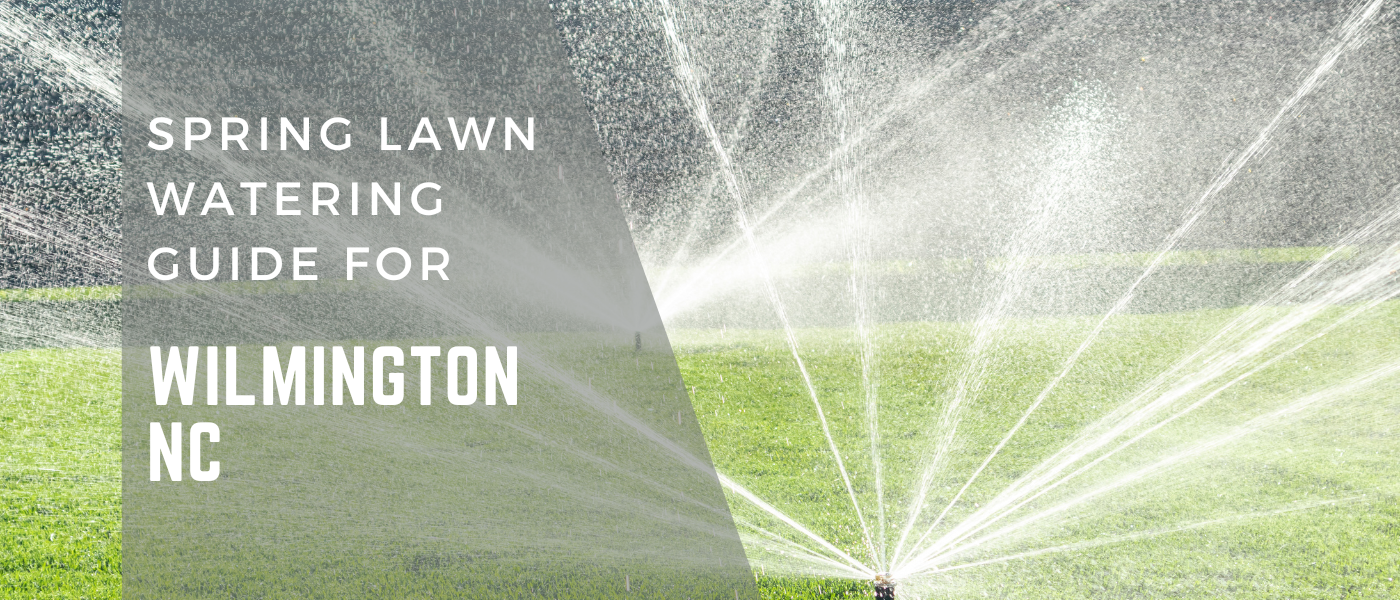
Spring Lawn Watering Guide for Wilmington, NC: 1-1.5 Inches Per Week
In this spring lawn watering guide for Wilmington, NC we go over how many inches to water per week, how to determine your sprinkler run times when to water and more.
As spring (March – April) approaches, it’s time to start thinking about your lawn’s watering needs. We’ve compiled an essential guide to help you keep your lawn healthy and vibrant throughout the season.
Please remember that rainfall and weather patterns can significantly impact your lawn’s water requirements, so it’s important to monitor conditions and adjust your watering accordingly. If it has rained heavily one day in a week, you may not need to water for several days.
To have a successful lawn care plan, it’s crucial that you do your part and ensure your lawn is watered correctly. Our guide will provide the information you need to get started, but it’s up to you to ensure your lawn receives the appropriate amount of water. With a little effort and attention, you can enjoy a lush, healthy lawn all season long.
Quick Guide
Task/Note | Details/Actions |
Watch for signs that your lawn is drying out | Monitor lawn regularly for signs of dehydration such as discoloration. |
Give your lawn 1 – 1.5 inches of water per week | Ensure lawn receives adequate water, adjusting for rainfall. |
Figure out your average watering time | Determine how long to water based on sprinkler output and lawn needs. |
Estimated average watering times by sprinkler type | Reference guide for different sprinkler systems (to be detailed). |
Note your “hotspots” | Identify areas that dry out faster or need more attention. |
Conserve water | Implement practices to reduce water waste, such as watering during cooler parts of the day. |
1. Your lawn will tell you when it needs more water. If you see cracks in the lawn, the turf is wilting; leaves are curling or folding, which shows that the turf needs water.
2. For your lawn to stay green, you need at least 1-1.5 inches of water per week.
3. Determine your total weekly run time to achieve 1-1.5 inches. We can give you averages, but every lawn and irrigation system differs.
Use catch cans (glass cups, coffee cans, etc.) and spread them around the zone. Run your system for 15 minutes and measure the water in the cup.
If in 15 minutes you get ¼ inch of water, you will have to run that zone for 60 minutes per week to achieve 1 inch of water. If you get ½ inch of water in 15 minutes, you must run it 45 minutes a week to achieve 1.5 inches of water per week.
Divide it between 3 – 4 days a week.
4. Average Run Times by Sprinkler Type. DISCLAIMER: Please remember that the averages listed below are only estimates. Every sprinkler system is different and will vary widely, as will plant and turf watering requirements.
- Spray head 180 – an average of 30 min. for 1 inch of water – 10 min. 3 days a week
- Rotors – an average of 2.5 hrs for 1 inch of water – 37 min. – 4 days a week
- MP Rotors –an average of 2.5 hrs for 1 inch of water – 37 min. – 4 days a week
Your plants and turf will be the first to tell you if they need more water.
5. Water early in the morning, 4-5 AM
The best time to water your lawn is early morning before the sun gets too high and the wind blows too hard. This will help the water soak into the soil and reach the roots of the grass. It will also help prevent the water from evaporating too quickly.
Watering your lawn early in the morning will also help prevent the grass from getting too wet and will ensure it will be dry by the time we/you need to mow.
6. Coverage issues are a big “watch out” for homeowners trying to grow an evenly green lawn.
You can apply the correct run times and water your lawn every week, but if you have coverage issues, you will see brown patches in your lawn – we call these “hot spots.”
Coverage issues result in some areas getting ½ inch of water while others may get 1 inch of water. Our NC heat will expose EVERY weakness in your sprinkler system. When it gets hot, the areas that get ½ inch will start to brown before those that get 1 inch do. This will make brown spots appear on your usually green lawn.
Improperly designed systems can cause coverage issues, heads not spraying correctly, low-pressure problems, wrong nozzles, heads spaced too far apart, etc.
7. Ensure that you are not over-watering your landscape and turf. Water conservation is critical to ensure we have water for many years. If it rains, you can reduce your irrigation for that week, depending on the amount of rain.
If your controller has seasonal adjustments, this is a great feature. Search for “seasonal adjustments” on the Internet to discover more info and learn how to use it.
In conclusion, this spring lawn watering guide simplifies the essential steps to maintain a vibrant and healthy lawn through the spring season. By focusing on adequate watering, adjusting for weather patterns, and addressing specific needs like hotspots and coverage issues, you can ensure your lawn stays lush and green.
Early morning watering and the smart use of technology for water conservation are key practices. With these tips, managing your lawn becomes a more straightforward task, promoting a beautiful outdoor space while respecting environmental resources.
